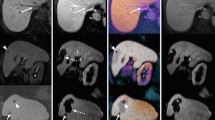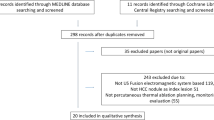Abstract
Purpose
To identify the more accurate reference data sets for fusion imaging-guided radiofrequency ablation or biopsy of hepatic lesions between computed tomography (CT) and magnetic resonance (MR) images.
Materials and Methods
This study was approved by the institutional review board, and written informed consent was received from all patients. Twelve consecutive patients who were referred to assess the feasibility of radiofrequency ablation or biopsy were enrolled. Automatic registration using CT and MR images was performed in each patient. Registration errors during optimal and opposite respiratory phases, time required for image fusion and number of point locks used were compared using the Wilcoxon signed-rank test.
Results
The registration errors during optimal respiratory phase were not significantly different between image fusion using CT and MR images as reference data sets (p = 0.969). During opposite respiratory phase, the registration error was smaller with MR images than CT (p = 0.028). The time and the number of points locks needed for complete image fusion were not significantly different between CT and MR images (p = 0.328 and p = 0.317, respectively).
Conclusion
MR images would be more suitable as the reference data set for fusion imaging-guided procedures of focal hepatic lesions than CT images.





Similar content being viewed by others
References
Lee MW, Rhim H, Cha DI, et al. Percutaneous radiofrequency ablation of hepatocellular carcinoma: fusion imaging guidance for management of lesions with poor conspicuity at conventional sonography. AJR Am J Roentgenol. 2012;198(6):1438–44.
Hirooka M, Iuchi H, Kumagi T, et al. Virtual sonographic radiofrequency ablation of hepatocellular carcinoma visualized on CT but not on conventional sonography. Am J Roentgenol. 2006;186(5_supplement):S255–60.
Lee MW, Rhim H, Cha DI, Kim YJ, Lim HK. Planning US for percutaneous radiofrequency ablation of small hepatocellular carcinomas (1–3 cm): value of fusion imaging with conventional US and CT/MR images. J Vasc Interv Radiol. 2013;24(7):958–65.
Liu FY, Yu XL, Liang P, et al. Microwave ablation assisted by a real-time virtual navigation system for hepatocellular carcinoma undetectable by conventional ultrasonography. Eur J Radiol. 2012;81(7):1455–9.
Mauri G, Cova L, De Beni S, et al. Real-time US-CT/MRI image fusion for guidance of thermal ablation of liver tumors undetectable with US: results in 295 cases. Cardiovasc Intervent Radiol. 2015;38(1):143–51.
Goldberg SN, Grassi CJ, Cardella JF, et al. Image-guided tumor ablation: standardization of terminology and reporting criteria. J Vasc Interv Radiol. 2009;20(7 Suppl):S377–90.
Ahmed M, Brace CL, Lee FT Jr, Goldberg SN. Principles of and advances in percutaneous ablation. Radiology. 2011;258(2):351–69.
Kim JE, Kim YS, Rhim H, et al. Outcomes of patients with hepatocellular carcinoma referred for percutaneous radiofrequency ablation at a tertiary center: analysis focused on the feasibility with the use of ultrasonography guidance. Eur J Radiol. 2011;79(2):e80–4.
Cha DI, Lee MW, Kim YK, et al. Assessing patients with hepatocellular carcinoma meeting the Milan criteria: is liver 3 tesla MR with gadoxetic acid necessary in addition to liver CT? J Magn Reson Imaging. 2014;39(4):842–52.
Kim SH, Kim SH, Lee J, et al. Gadoxetic acid-enhanced MRI versus triple-phase MDCT for the preoperative detection of hepatocellular carcinoma. AJR Am J Roentgenol. 2009;192(6):1675–81.
Lee JY, Choi BI, Chung YE, Kim MW, Kim SH, Han JK. Clinical value of CT/MR-US fusion imaging for radiofrequency ablation of hepatic nodules. Eur J Radiol. 2012;81(9):2281–9.
Lee MW. Fusion imaging of real-time ultrasonography with CT or MRI for hepatic intervention. Ultrasonography. 2014;33(4):227–39.
Cha DI, Lee MW, Kim AY, et al. Automatic image fusion of real-time ultrasound with computed tomography images: a prospective comparison between two auto-registration methods. Acta Radiol. 2017. doi:10.1177/0284185117693459.
Cha DI, Lee MW, Song KD, et al. A prospective comparison between auto-registration and manual registration of real-time ultrasound with MR images for percutaneous ablation or biopsy of hepatic lesions. Abdom Radiol. 2017. doi:10.1007/s00261-017-1075-x.
Crocetti L, Lencioni R, DeBeni S, See TC, Della Pina C, Bartolozzi C. Targeting liver lesions for radiofrequency ablation: an experimental feasibility study using a CT–US fusion imaging system. Invest Radiol. 2008;43(1):33–9.
Suramo I, Paivansalo M, Myllyla V. Cranio-caudal movements of the liver, pancreas and kidneys in respiration. Acta Radiol Diagn (Stockh). 1984;25(2):129–31.
Balter JM, Ten Haken RK, Lawrence TS, Lam KL, Robertson JM. Uncertainties in CT-based radiation therapy treatment planning associated with patient breathing. Int J Radiat Oncol Biol Phys. 1996;36(1):167–74.
Shimizu S, Shirato H, Xo B, et al. Three-dimensional movement of a liver tumor detected by high-speed magnetic resonance imaging. Radiother Oncol. 1999;50(3):367–70.
Mauri G, De Beni S, Forzoni L, et al. Virtual navigator automatic registration technology in abdominal application. Conf Proc IEEE Eng Med Biol Soc. 2014;2014:5570–4.
Kadoury S, Wood BJ, Venkatesan AM, Ardon R, Jago J, Kruecker J. Graph-based surface extraction of the liver using locally adaptive priors for multimodal interventional image registration. In: Proc. SPIE 8316, Medical imaging 2012: image-guided procedures, robotic interventions, and modeling. 2012. doi:10.1117/12.911363.
Wein W, Brunke S, Khamene A, Callstrom MR, Navab N. Automatic CT-ultrasound registration for diagnostic imaging and image-guided intervention. Med Image Anal. 2008;12(5):577–85.
Kunishi Y, Numata K, Morimoto M, et al. Efficacy of fusion imaging combining sonography and hepatobiliary phase MRI with Gd-EOB-DTPA to detect small hepatocellular carcinoma. AJR Am J Roentgenol. 2012;198(1):106–14.
Acknowledgements
This study was supported by a Samsung Medison Grant [#PHO0132251].
Author information
Authors and Affiliations
Corresponding author
Ethics declarations
Conflict of interest
The funder only provided support in the form of salaries for authors who are employees of Samsung Medison. Authors who are employees of Samsung Electronics Co. [Y.O., J.J., J.C., J.R., K.J.L., J.K. and W.C.B.] or Samsung Medison [D.K.S., S.J.C. and D.K.] participated in the development of the S-Fusion, provided technical advices and analysis tools during the clinical trial and contributed in writing the manuscript, especially technical parts. Only the authors from Samsung Medical Center, Department of Radiology, had full control of the study design, data collection, decision to publish or preparation of the manuscript. One author (M.W.L.) is also a consultant for Samsung Medison.
Ethical Approval
All procedures performed in studies involving human participants were in accordance with the ethical standards of the institutional and/or national research committee and with the 1964 Declaration of Helsinki and its later amendments or comparable ethical standards.
Informed Consent
Written informed consent was obtained from all patients for this prospective study.
Rights and permissions
About this article
Cite this article
Cha, D.I., Lee, M.W., Kang, T.W. et al. Comparison Between CT and MR Images as More Favorable Reference Data Sets for Fusion Imaging-Guided Radiofrequency Ablation or Biopsy of Hepatic Lesions: A Prospective Study with Focus on Patient’s Respiration. Cardiovasc Intervent Radiol 40, 1567–1575 (2017). https://doi.org/10.1007/s00270-017-1666-5
Received:
Accepted:
Published:
Issue Date:
DOI: https://doi.org/10.1007/s00270-017-1666-5




